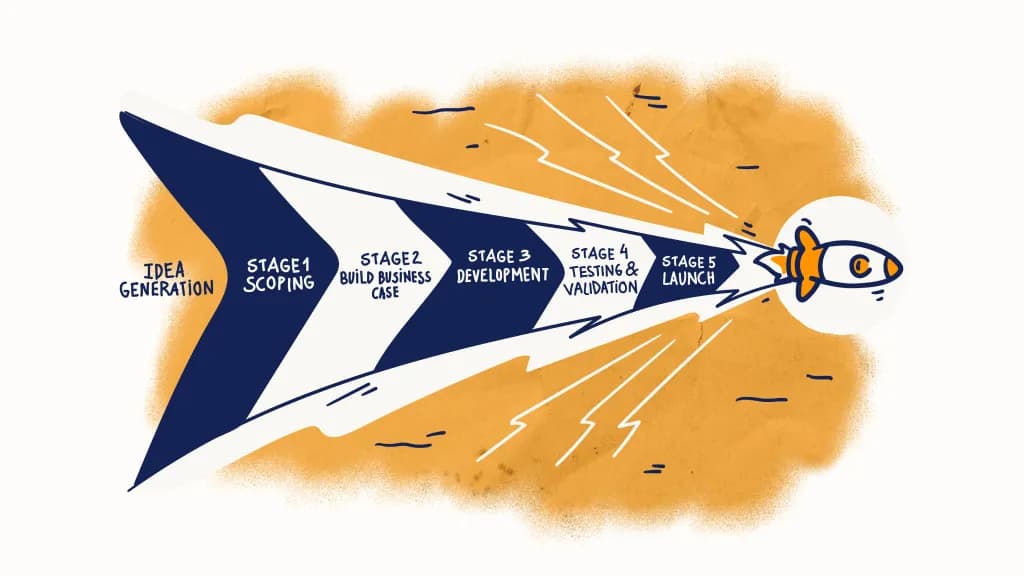An innovation process is a structured way of handling new ideas from start to finish. It involves several stages — from generating ideas from different sources to collaboratively assessing, developing, testing, and finally implementing them.
The key attribute of an innovation process is that it’s a systematic and repeatable set of steps you use to innovate.
But to drive innovation successfully, you need to manage the innovation process well. This includes defining the stages and activities of your process, and ensuring new ideas are aligned with your organization’s strategic goals.
In our experience, however, most companies, even those touting an innovation strategy or mission, don’t manage the process thoroughly. As a result, we see:
Companies having a loose idea collection system instead of a much-needed innovation process to bring promising ideas to life.
Too many ideas being submitted on random topics, and not enough connected to current initiatives, innovation goals, or the overall business strategy.
A small team in charge of filtering through thousands of ideas — an unreasonable ask — leaving many (potentially good) ideas untouched.
Little to no process for idea feedback, assessment, and validation (meaning what’s supposed to be an “innovation process” turns into glorified idea collection).
We’ve witnessed these issues firsthand for more than a decade as consultants on innovation systems and solutions — that’s why we created InnovationCast, an innovation process management platform, to help organizations succeed at fostering growth and efficiency faster and more often.
In this article, we describe what you need to know about innovation process management, including:
What innovation management is, and why it’s important
The steps of an efficient innovation process
Best practices for managing your innovation process
Examples of successful innovation process management
What Is an Innovation Process?
An innovation process is a systematic approach that companies and organizations use to capture, validate, incubate, and implement new ideas. It’s a planned and structured series of steps for handling ideas from their initial spark to implementation.
We emphasize the “series of steps” because, as mentioned above, many organizations simply collect ideas from employees and consider that an innovation process. But it’s not.
A true process for innovation includes multiple stages, from ideation to implementation, where ideas are discussed, filtered, validated, iterated, reassessed, and implemented. This is necessary to turn idea collection into a process that actually produces innovations (whether it be new products, business models, or any other innovation that helps the organization).
Finally, we’ve found that the process should be open and transparent so as many employees as feasible can contribute to the program. Including a wider employee base in your efforts improves the chances of more (and better) ideas being submitted.
3 Steps Every Innovation Process Needs
A well-managed innovation process typically includes these three stages:
Idea collection: The more structured the idea input process is in terms of addressing specific topics, the better aligned these ideas will be with respect to organizational goals.
Feedback and discussion: Employees across the organization should be able to view, comment on, and refine submitted ideas, engaging in a collaborative dialogue. In this stage, you move beyond mere idea collection, and actively solicit wide participation from employees to give feedback. The more employees you have reading ideas, giving actionable feedback, asking questions, and rating ideas, the more likely you are, as an organization, to find (or iterate your way to) good innovations.
Idea assessment: Stakeholders analyze ideas using set criteria (e.g., risk levels or market potential) or frameworks (e.g., business model canvas or Design Thinking) to decide which ideas should advance to testing and eventual implementation phases.
How InnovationCast Supports the Innovation Process
We decided to build InnovationCast years ago when we were consulting with companies on their innovation and collaboration processes and noticed that existing platforms didn’t have the features we felt were necessary to support a productive innovation process with the steps outlined above (you can read our full story here).
Below are the features we designed into InnovationCast to execute on the process outlined above:
Step 1: Gather and Refine Ideas
As previously mentioned, many companies gather ideas by soliciting these via a web form or email address (e.g. ideas@company.com). This has a major flaw of lacking transparency for most employees. Employees submit ideas and get little to no feedback on what happens to those, as only the group managing the collection process can view and decide on the fate of the submitted ideas.
In addition, a generic idea collection system doesn’t encourage ideas that address specific, targeted problems or opportunities that are current priorities for the organization. Without specific instruction or guidance, most employees will simply submit ideas for incremental innovations to aspects of their daily work life, not ideas related to that quarter or year’s major organizational goals.
InnovationCast solves these problems in a number of ways.
Soliciting Challenges on Specific Topic Areas
We created a Challenges feature to let teams create a time-bound solicitation for ideas on a specific topic where you’re given ample room to explain the background and context behind why the organization is asking for ideas on this topic. We’ve found that it’s a really effective way to focus your organization’s brainstorming on particular problems and opportunities.
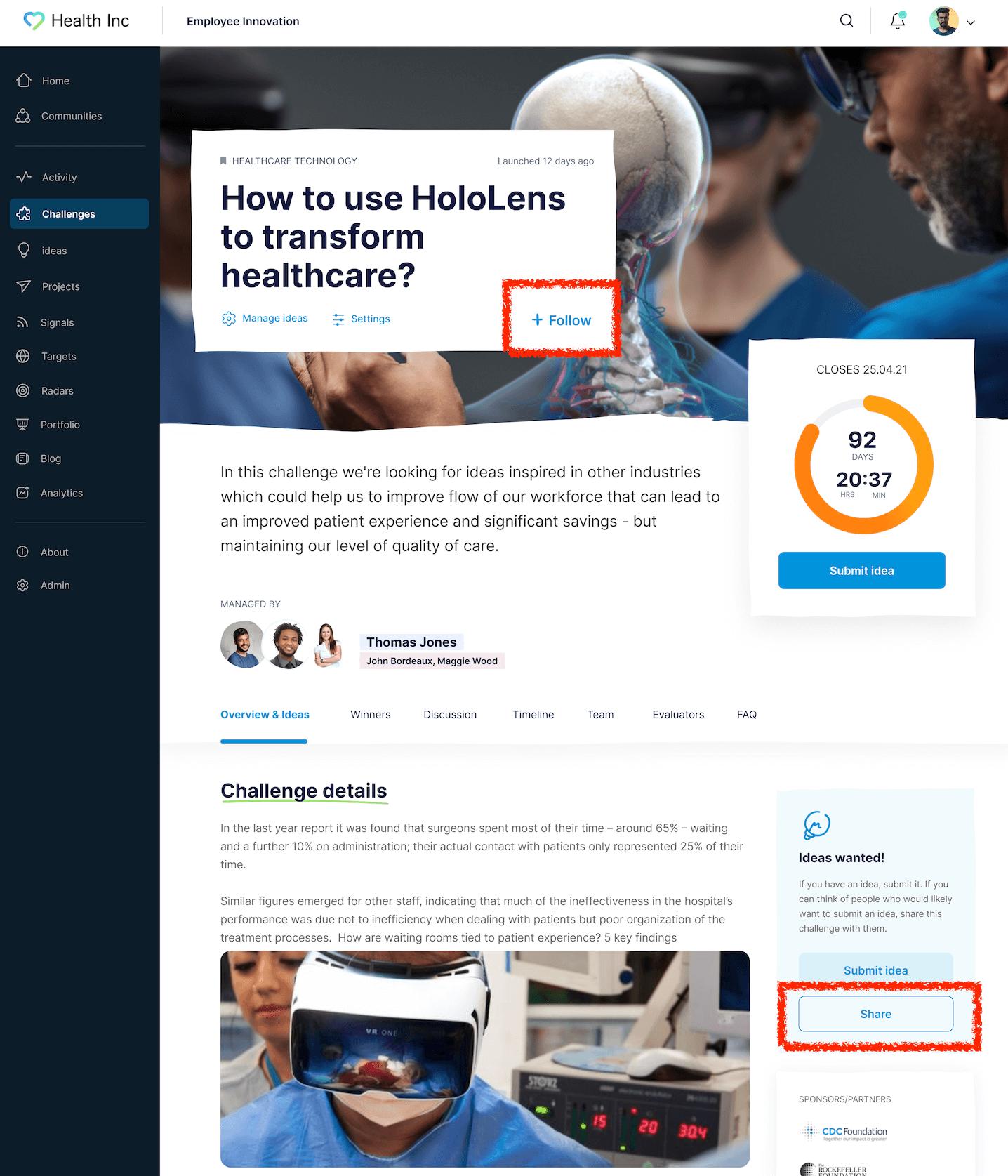
As you can see above, a Challenge gives you room to specify a lot of details around what ideas they’re looking for: background on the business need or problem, what the organization wants to achieve, what has already been done, what kind of ideas they are looking for, restrictions or boundary conditions for the ideas, and more.
In our experience, this context dramatically improves the quality of ideas that employees submit. Finally, Challenges are also usually time-bound, with a deadline that adds a sense of urgency to prioritize idea submission.
Boosting Engagement and Idea Visibility
To boost engagement in the innovation process, we’ve added social design buttons like “Follow” and “Share” — you can see these highlighted in the Challenges diagram directly above.
Following a Challenge notifies you when a new idea is submitted, or any other major changes to the Challenge are made. This encourages employees who might not have their own ideas to participate and stay engaged in the innovation process.
Read more: How to Build an Organization-Wide Employee Innovation Program
Vetting, Refining, and Getting Feedback for Idea Development
In a thriving collaborative environment, you want employees to give as much feedback as possible, challenge an idea, and call out when an idea is good. Normally this vetting is done by innovation team members, but they may not have the capacity to vet and refine all ideas thoroughly.
Crowdsourcing this function to your entire employee base can be really effective. And if some idea that the innovation department wouldn’t have found happens to get a ton of attention from employees, it’ll get noticed by the innovation department.
Detailed feedback is important, and a simple “Like” button is often insufficient: you need discussion, questions, comments, and further idea development. So to encourage this, we designed an actionable feedback system geared to improve the quality of the ideas, even before they are assessed by the organization:

When a user clicks “Looks great,” they don’t need to explain why they voted this way. It is used to measure community support for the idea and avoid comments that can clutter the idea discussion, such as “I like it / looks good to me,” etc
The other two buttons, “I have questions” and “Needs work,” require explicit questions and further discussion about the idea. If someone thinks the idea needs work, one needs to explain why; this gives the author the chance to address objections. Authors can respond to questions or comments, create new discussion threads, or edit their ideas.
This transforms lonely idea submission into a flourishing company-wide community around discussing the most interesting ideas. And this is how you build the often sought-after “culture of innovation” in your organization.
Beyond voting, when Idea or Challenge initiators receive particularly insightful feedback, they have the ability to mark this as a "Significant Contribution." This fosters an environment where participants are motivated to provide thoughtful and beneficial suggestions and to receive recognition for this.

Step 2: Assess and Validate Ideas
After you’ve gathered and discussed a number of ideas, it’s time to evaluate and test them against specific criteria. This involves a deeper analysis of each idea's feasibility, market viability, alignment with the company's objectives, potential business growth and opportunities, and necessary resources.
When we were consulting with enterprises on their innovation efforts and collaboration systems, we noticed that these “post-idea collection” steps were often done ad hoc.
Submitted ideas deemed promising were handed over to specific teams or departments that worked on that part of the business, and those teams took over working on that idea. Little visibility or transparency was left for the employees who originally submitted ideas, and the process steps that ideas would go through for validation and assessment were unstructured. This has several downsides:
Many ideas just sat on the shelf and withered away without the structure and visibility that a systematic approach gives.
There is no structure to guide the work required to validate ideas.
Lack of collaboration and transparency decreases motivation for the wider organization to continue to participate in the innovation program (because they can’t see what happens to the ideas once they submit them).
It’s hard for the innovation department or leaders to keep pushing on these ideas because they become part of the purview of specific departments.
We think instead that having a structured, systematic, and transparent process for idea assessment and validation fixes these problems. Below is how this process works in InnovationCast, but if you are designing your own system that uses the same principles, that should also get you similar benefits.
Workflows: A Systematic and Phased Approach to Innovation
In InnovationCast, ideas that qualify or are chosen to be further assessed are promoted to the next step using predefined innovation workflows for further development and testing.
Workflows in InnovationCast are essentially processes for different types of innovations; they consist of a series of structured steps and activities for validating ideas across categories.
They make the innovation process transparent and clear and allow stakeholders to observe an idea's progression, understand its present stage, and recognize the actions executed at every phase.
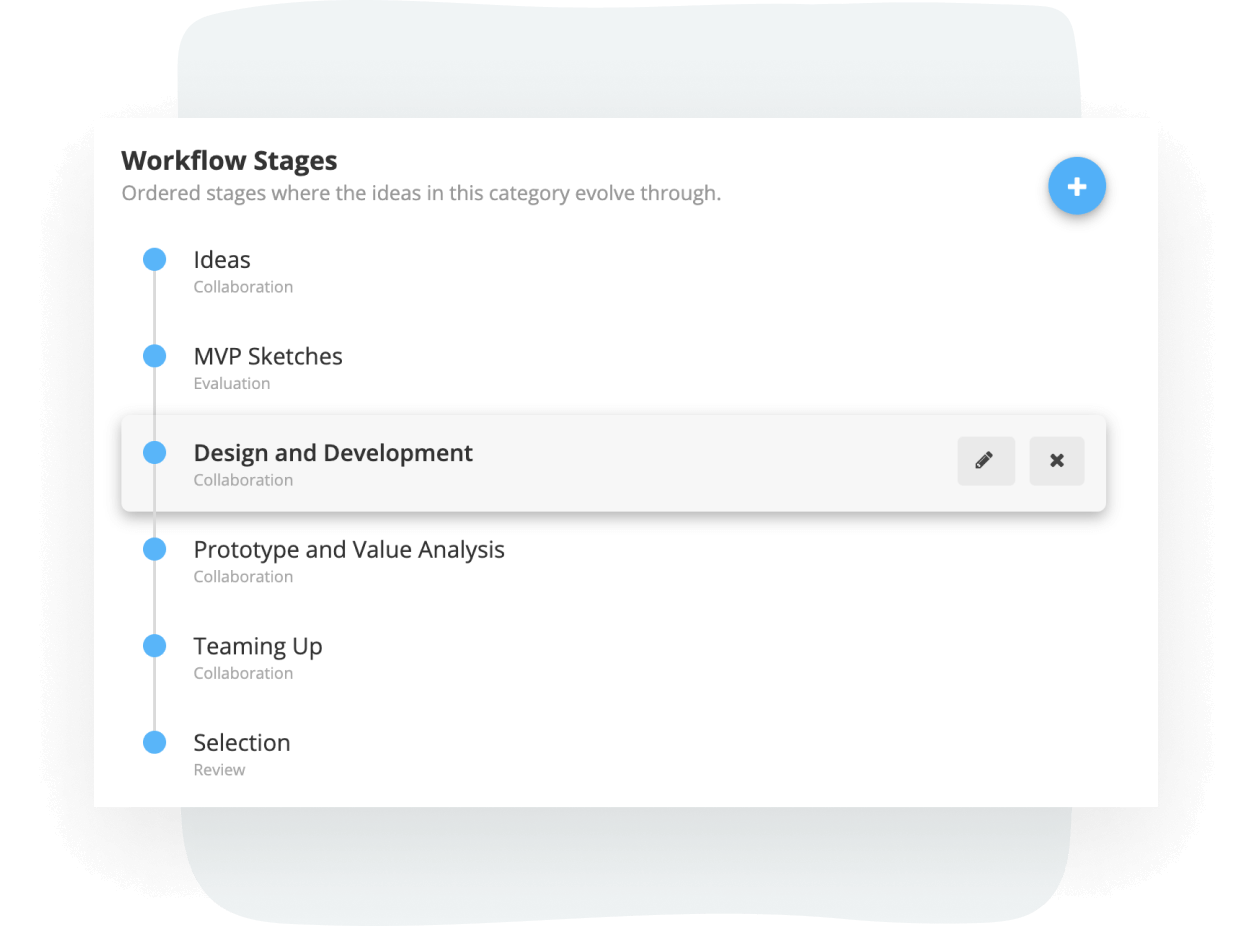
We’ve discussed how InnovationCast enables you to use or design different workflows for different areas of your business. By “designing” different workflows, you can choose the stages comprising them.
In addition, each stage can have a very specific set of people, criteria, details, questions, or sub-tasks, such as specifying the questions that need to be answered, the assumptions and hypotheses needing to be validated via experiments, the tasks to be completed (prototyping for new product development, for example), and more.
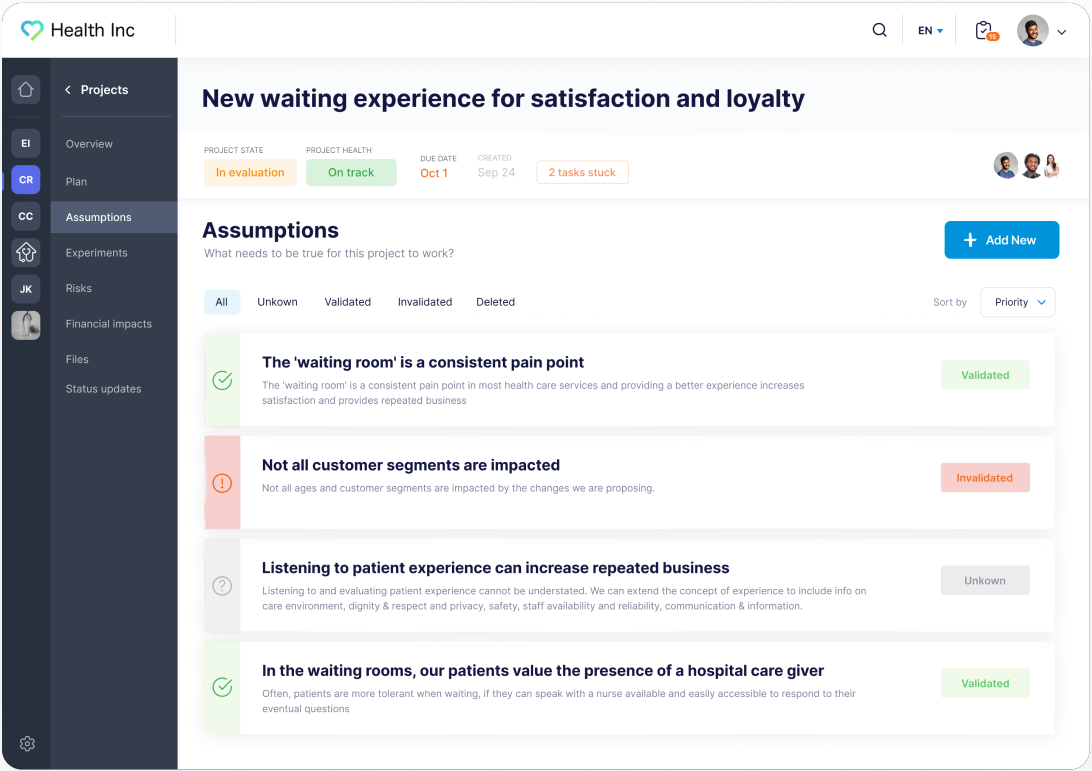
In contrast to other systems on the market, InnovationCast makes designing your own workflows simple and doesn’t require any IT training or development.
We believe you should use a custom workflow model for every business and function in your organization. A one-size-fits-all approach to innovation isn’t likely to work. People usually take ideas offline for further development while ignoring the formal steps of the process.
Innovation Project Management
Many companies use standard project management tools like Asana for managing innovation projects, however, such tools weren’t created for collaboratively developing and validating ideas.
InnovationCast has dedicated project management features that allow you to track the overall status of your projects and tasks:
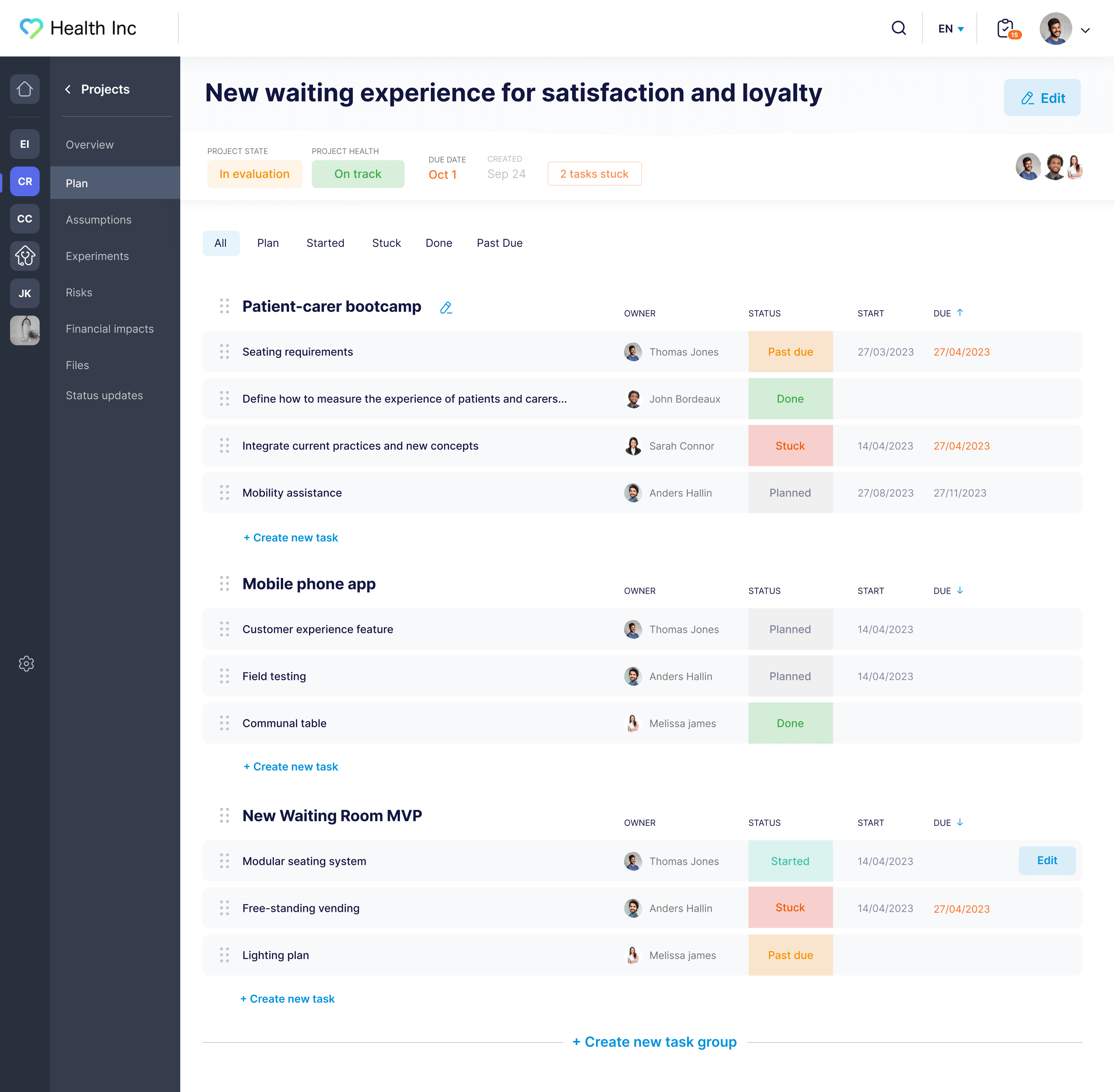
InnovationCast’s innovation project management features have the added benefit that you don’t need to switch tools for those functions, and everyone can follow the steps being taken to test and validate ideas, providing guidance and structure to the teams doing the work.
Two Additional Best Practices for Managing Your Innovation Process
In addition to executing on the innovation process steps above, we’ve found that a good process should also have these two traits:
It should introduce transparency and collaboration to the entire organization (or whoever should reasonably be included) at each stage of the process.
It should be centralized in a single platform or tool so everyone knows where information is organized.
1. Introduce Transparency and Collaboration at Each Stage of the Process
As we’ve mentioned, there’s a tendency among companies to confine innovation activities to a single department or team that is likely to discuss and evaluate ideas only among themselves. Ideas and projects can emerge from any level of the organization, but frame-breaking ideas require multiple competencies and buy-in from multiple stakeholders.
The wider organization is usually not invited to examine and provide feedback on ideas, which limits the diversity and depth of perspectives.
Our philosophy is that innovation should be a distributed function that depends on the input and collaboration of all involved. We recommend making your innovation process as transparent and collaborative as possible to encourage participation from employees and help them feel more connected and invested in outcomes.
InnovationCast incorporates transparency and collaboration as a basic feature in all its steps.
All employees of your organization can become users of InnovationCast and participate in the innovation process. For instance, when a user logs in to the system, they’re greeted by an Activity Feed showing the latest idea submissions, comments, and suggestions from everyone:

An employee can browse all ideas under active discussion and decide whether to join the discussion or give feedback.
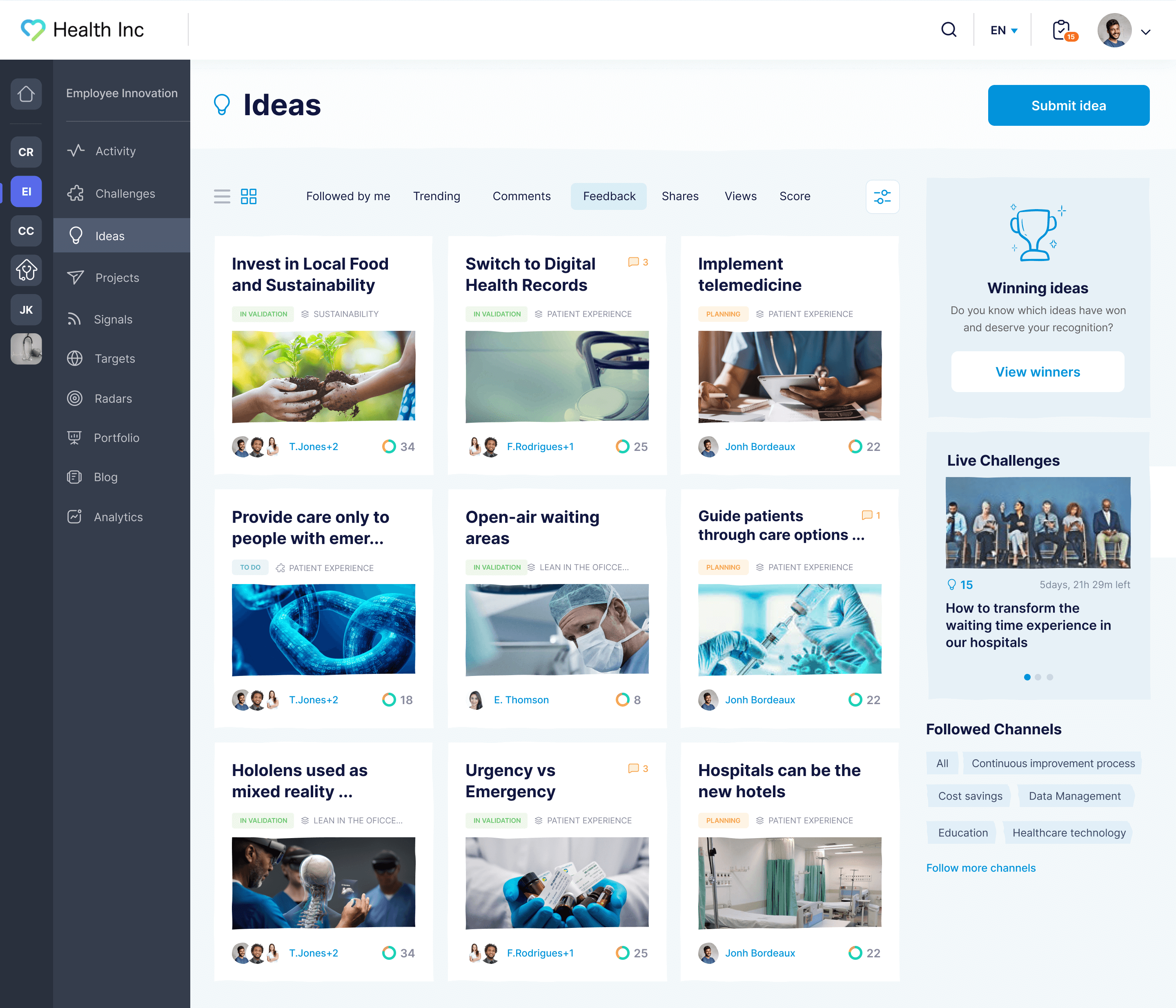
These and other features of InnovationCast show how an innovation process designed with transparency and collaboration in mind can help build enthusiasm and trust and pull everyone together.
2. Centralize Innovation Management within a Unified Platform
Centralizing your innovation process — across your entire organization and in a single platform:
Allows you to crowdsource idea submission and refinement, sourcing a wider range of ideas, insights, and solutions rather than relying on a smaller group of people to do this.
Since you’re sourcing a wider audience for ideas, more opportunities for sharing and feedback naturally give rise to more constructive criticism and problem-solving, increasing the potential for idea refinement and development.
Introduces an element of automation in the innovation process since software takes over manual tasks to manage workflows, notifications, and more. This leaves more space for employees to do innovation, rather than administration.
Allows your innovation activities to scale over the entire organization.
One big benefit of unifying innovation management onto a single platform is that once employees access a central innovation process, you get a “sharing economy” of new ideas.
Two particular features of InnovationCast highlight this:
Insights Sharing
Our Signals feature (or “distributed Scouting”) allows users to share and discuss relevant insights that can lead to new innovation challenges, ideas, or projects. Users share updates on new technologies, new market trends, feedback from customers, and startup developments.
Colleagues within the organization can access these updates, engage in discussions via comments, and use this stream of information as a catalyst for innovative ideas.
Before posting a signal to the main dashboard, users are asked to include a brief explanation or rationale for sharing it. This ensures that others can quickly grasp the article's significance, fostering more meaningful discussion.
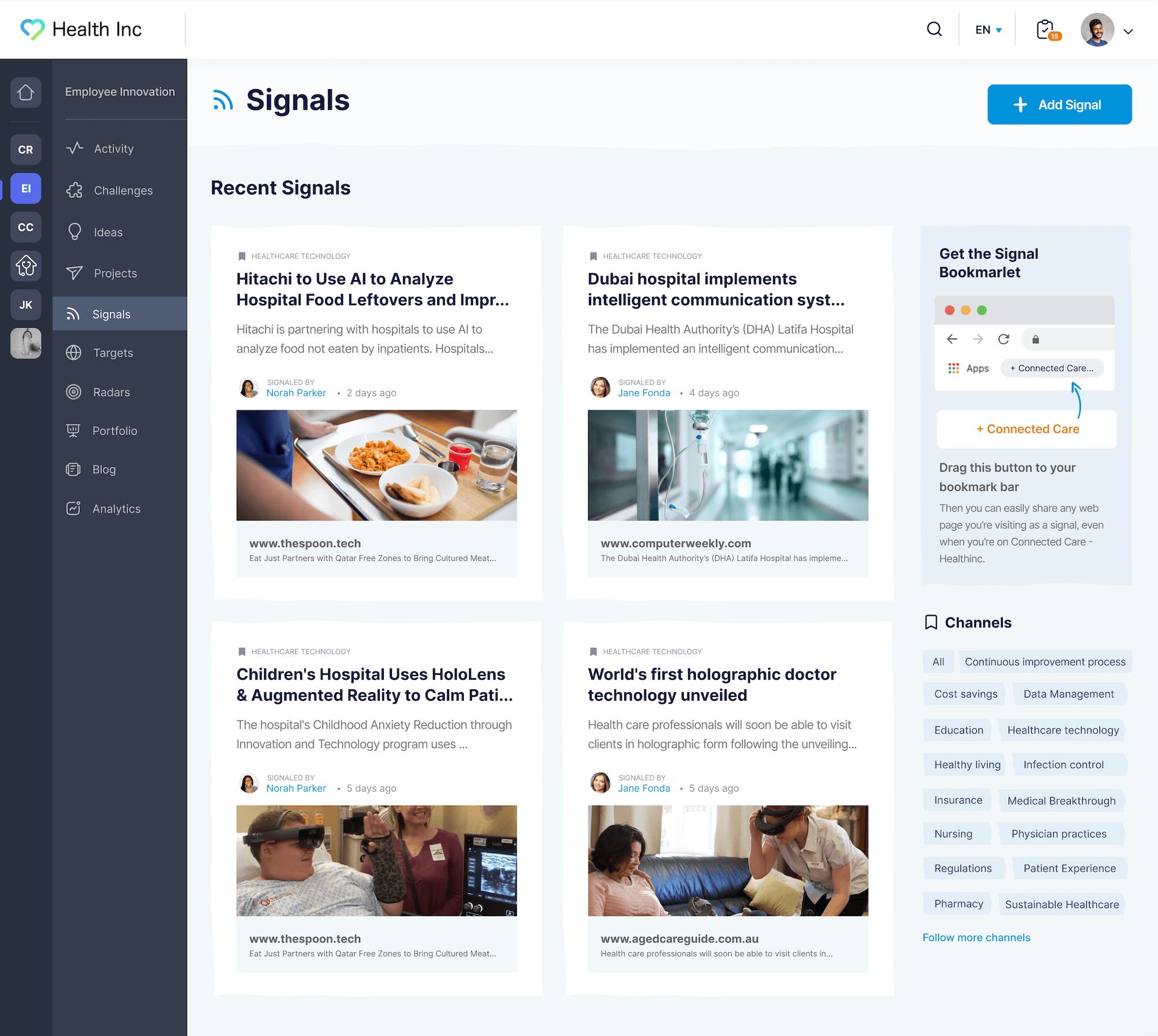
Innovation Radars
Radars allow users to categorize submissions according to specific areas of interest. This brings a structured approach to managing insights and offers interesting context. Users gain insight into the topics that are being actively monitored by the team, encouraging them to contribute relevant articles and ideas.

Radars highlight topics that draw more interest through increased submissions while also allowing users to explore less active areas. Users can access detailed insights, trends, and collective articles by exploring a specific Radar, offering opportunities to contribute new articles and feedback while reviewing existing comments and content.
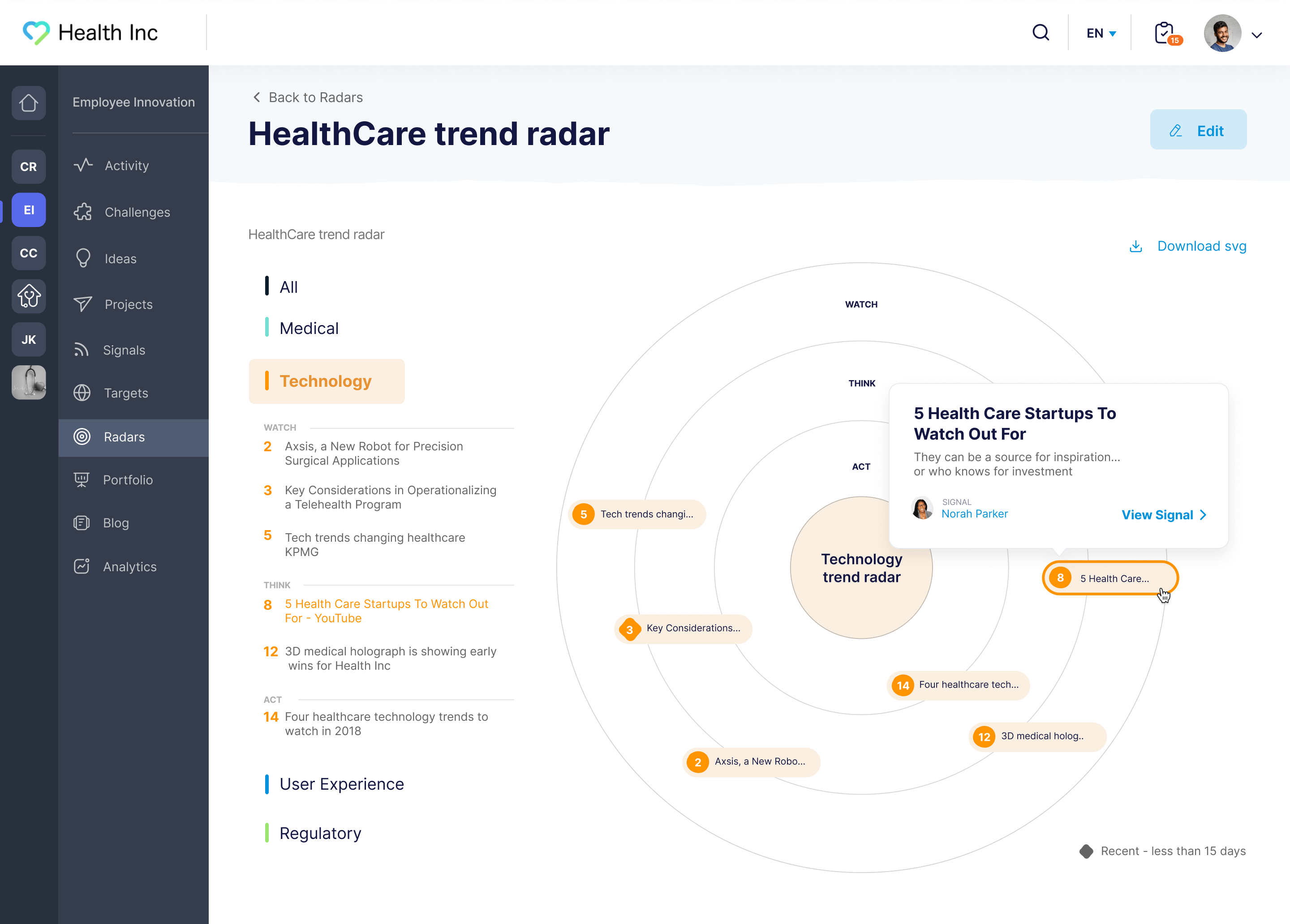
These features show that innovation isn’t just about new idea generation. It’s about encouraging participation to create an engaging, interactive, and open environment where every voice is heard and every idea has the potential to spark change.
Read more: 6 Innovation & Idea Management Software (Comparison)
Innovation Process Management Examples
The following two case studies show examples of effective innovation management.
How DHL Tapped Into Diverse Perspectives in Innovation
German logistics company DHL employs over 5000 personnel in its IT services division alone and was seeking a way to harness the brainpower and ideas of its employees to find better ways to support its business units worldwide.
However, creating an environment for these ideas to be shared, assessed, and brought to fruition in a collaborative manner was a formidable task. This challenge was compounded by the company’s existing focus on logistical operations management systems, which were not optimized for managing the flow of innovative ideas.
As a result, numerous valuable ideas and potential solutions were confined within the boundaries of regional and departmental silos, untapped and underutilized. Recognizing the need for a more integrated approach to innovation, DHL sought a solution that would gather these ideas and facilitate their collective implementation across the organization.
To achieve this, DHL partnered with InnovationCast to introduce their own innovation management platform, IdeaHub. This platform incorporated DHL’s innovation management process and provided a highly collaborative environment for gathering and promoting ideas.
Utilizing IdeaHub resulted in a more effective innovation process:
The number of submitted ideas increased by 67%.
New ideas now take 4 weeks from launch to implementation.
14% of all submitted ideas have been implemented within two years.
How Novo Nordisk Improved Transparency and Reporting in Its Innovation Projects
Novo Nordisk A/S — a multinational pharmaceutical company headquartered in Denmark and employing nearly 50,000 employees in 168 countries — acknowledged the challenge of managing innovation across such a vast and diverse organization.
They lacked a central platform for managing innovation projects, which brought issues of transparency, reporting, and tracking in their processes.
The company’s search for an innovation process management platform led it to InnovationCast, where they created an innovation hub called Spark. The platform:
Used Single Sign On (SSO) to onboard employees, where their profiles and job titles were highlighted. This encouraged employees from diverse departments and regions to connect and collaborate, breaking down the silos that often hinder innovation in large organizations.
Integrated InnovationCast’s Power BI connector to enable the creation of dynamic and informative-rich dashboards, offering managers a high-level perspective of the innovation landscape. This feature allowed for the categorization and analysis of projects by various criteria, such as therapy area and project status, thereby streamlining decision-making processes.
The overall impact of Spark was that it introduced much greater transparency and accountability regarding the multitude of ongoing innovation initiatives within the organization, a strategic implementation that led to remarkable outcomes:
It has improved decision-making with more accurate portfolio reporting.
More than 10 pharmaceutical product lifecycles are impacted.
Several hundreds of innovation projects are managed within the platform.
Elevate Your Innovation Process
Without the right platform and tools at your disposal, navigating innovation management can be daunting. InnovationCast is a dynamic and collaborative platform designed to effectively manage your innovation journey. Our system is more than just a tool; it centralizes and transforms your scattered ideas into impactful, real-world projects.
Schedule a free demo and consultation to see how InnovationCast can help you manage your innovation processes.

